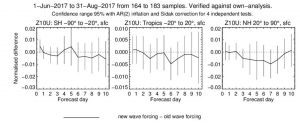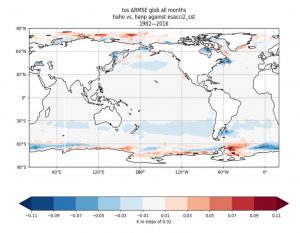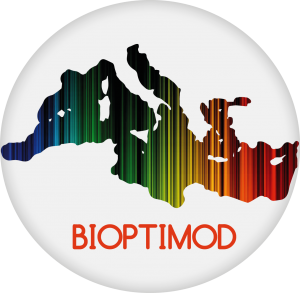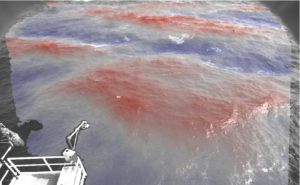CONSISTENT WAVE-MEAN FLOW MODELLING IN COUPLED MODELS
PI and organization: O. Breivik (MET No)
Co-Is: J. Staneva (HZG), J-R.Bidlot (ECMWF), G. Nurser (NOCS
The WaveFlow project addresses the impact that unresolved wave-mean flow effects have on the circulation in the upper ocean. Specifically, the project introduces recent improvements to the physical parameterizations of wave physics (Ardhuin et al, 2010) in a state-of-the-art wave model (WAM) used for operational wave forecasting in several MFCs. The wave fields and fluxes are implemented in an openly available wave model code (WAM 4.7) and tested with fields and fluxes from a decades-long wave hindcast of the ERA-5 reanalysis. The tests have been carried out on all scales pertinent to CMEMS, ranging from vertical column one-dimensional setups of NEMO4 to regional, high-resolution models (ARC-MFC) and all the way to global ocean-only and fully coupled atmosphere-wave-ocean forecast systems (ECMWF IFS). The project has explored the beneficial impact on the predictability of forecast systems and the potential improvement to the circulation of the upper ocean. In addition, changes to NEMO have also been introduced, specifically the Stokes drift material and tracer advection (Wu et al, 2019a).
WaveFlow has as its main objective to Introduce physically consistent surface-wave forcing in ocean-only and coupled atmosphere-wave-ocean model.
The following R&D objectives has helped us achieve this:
- Assess the impact of wave effects on currents and hydrography in the upper ocean. 8. Introduce new wave model physics in operational wave models.
- Assess the impact of wave-mean flow on coupled forecast systems
The methodology followed in the WaveFlow project has been as follows.
- A new open-source wave model which embodies new physical parameterizations was developed.
- A wave hindcast based on ERA-5 winds with the new wave model physics was performed which yields wave forcing fields that can be used for testing the ocean model.
- Forced ocean model integrations were performed. This was done on various domains and resolutions.
- Fully coupled systems (global) and regional wave-ocean systems were tested to assess the impact on the atmosphere-wave-ocean system, with special attention to the predictability of upper-ocean currents.
- The quality of the wave hindcasts was assessed in terms of new spectral metrics.
- The ocean circulation was evaluated with drifter and current observations available to the project partners.
- Integration with existing CMEMS MFCs has been facilitated through interaction with regional and the global MFCs as the results from the project started to emerge.
The WaveFlow project has delivered a major upgrade of the open source version of WAM, v4.7. This version includes the physics package from Ardhuin et al (2010) as implemented in EC-WAM, the wave model component of the Integrated Forecast System of ECMWF. The forcing is provided by ERA-5 and a set of hindcast integrations where EC-WAM is run with ERA-5 wind forcing with and without the new physics.
A coupled experiment with the new wave forcing (AR) in the ECMWF IFS is shown in Fig 2 below. Here we compare a control run with the old wave forcing. Values below 0 indicate an improvement as the differences between forecasts and the analysis are smaller with the new wave forcing is used. The new wave model physics represents a significant improvement. This model code is now openly available to CMEMS MFCs.
The updated NEMO4 with Stokes drift advection included has been tested in WaveFlow (Wu et al, 2019a). This new NEMO model code is also available to CMEMS MFCs.
 Figure 1. Normalised difference in root-mean-square deviation for the u-component of 10m wind (ZU10) forecasts from two experiments when compared to their own analysis fields for the Southern Hemisphere (SH), the Tropics, and the Northern Hemisphere (NH). The experiments were carried out with ECMWF Earth System model by running 12h analyses followed by 10 day forecasts for the period from 1 June to 31 August 2017 at Tco399 resolution. The experiment with the new wave forcing is compared to a control run with the old wave forcing. Values below 0 indicates that the differences between forecasts and the analysis are smaller when the new wave forcing is used.
Figure 1. Normalised difference in root-mean-square deviation for the u-component of 10m wind (ZU10) forecasts from two experiments when compared to their own analysis fields for the Southern Hemisphere (SH), the Tropics, and the Northern Hemisphere (NH). The experiments were carried out with ECMWF Earth System model by running 12h analyses followed by 10 day forecasts for the period from 1 June to 31 August 2017 at Tco399 resolution. The experiment with the new wave forcing is compared to a control run with the old wave forcing. Values below 0 indicates that the differences between forecasts and the analysis are smaller when the new wave forcing is used.
 Figure 2. Difference in root-mean-square deviation of NEMO4, ORCA1_Z75 forced by ERA-5 or the ERA-5 hindcast with all wave forcing (ERA-5 hindcast – ERA-5). Model sea surface temperature (SST) is compared to satellite based SST from ESA CCI v2 from 1984 to 2016. Blue shades mean that differences between model and observations are smaller when the ERA-5 hindcast data are used.
Figure 2. Difference in root-mean-square deviation of NEMO4, ORCA1_Z75 forced by ERA-5 or the ERA-5 hindcast with all wave forcing (ERA-5 hindcast – ERA-5). Model sea surface temperature (SST) is compared to satellite based SST from ESA CCI v2 from 1984 to 2016. Blue shades mean that differences between model and observations are smaller when the ERA-5 hindcast data are used.


